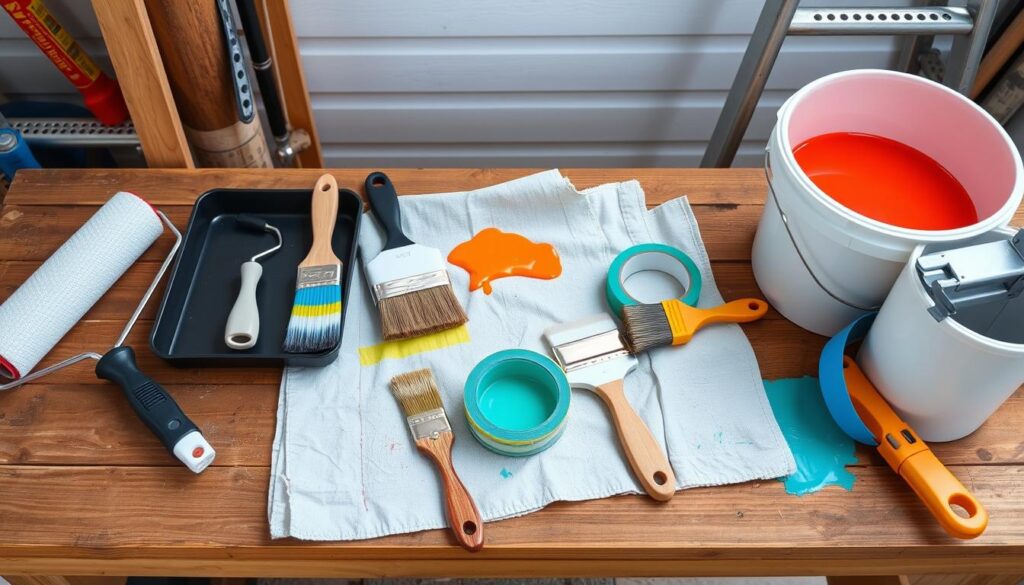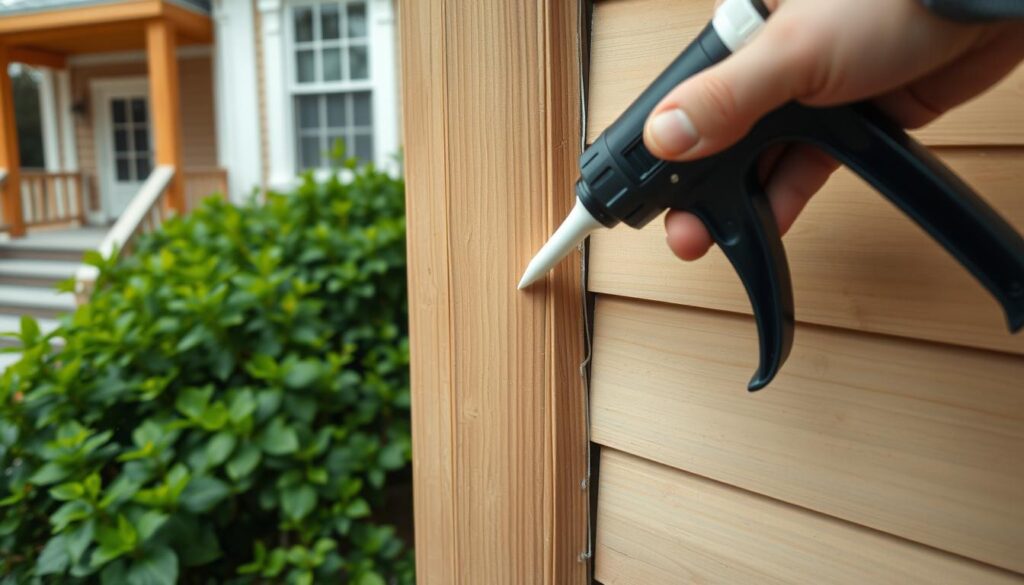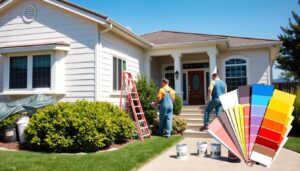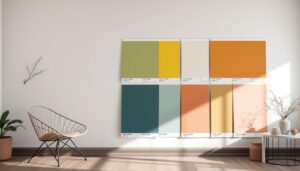Did you know that high-quality exterior paints can resist fading and peeling by up to 90% over time? This remarkable statistic underscores the importance of preparing your home for exterior painting. When you commit to thorough house painting preparation, not only do you enhance the aesthetic appeal of your property, but you also strengthen its defenses against harsh weather elements, boosting its overall value.
This guide will walk you through every crucial step of preparing your home for exterior painting. From evaluating the right weather conditions to choosing the appropriate tools and materials, you’ll gain insights that ensure a successful painting project. With proper preparation, you can achieve a finish that lasts and looks stunning for years to come. Let’s dive into the essential steps needed to transform your home’s exterior efficiently and effectively.
Key Takeaways
- Exterior painting requires a temperature range of 10 – 32°C (50-90°F) for optimal adhesion.
- Applying two coats of paint significantly increases durability and longevity.
- High-quality exterior paints can offer up to 10 years of lasting coverage.
- Utilize primer on areas with cracked or peeling paint to ensure better adhesion.
- Always check weather conditions to avoid painting in extreme heat or rain.
- Reduce paint splatter by avoiding windy days when painting exteriors.
Importance of Proper House Painting Preparation
Proper house painting preparation plays a vital role in achieving a long-lasting and appealing exterior finish. Effective Exterior Paint Prep ensures that paint adheres effectively while protecting the underlying materials of your home from potential damage. A lack of thorough preparation can lead to issues such as peeling paint and moisture penetration, which may ultimately reduce your property’s value.
In Australia, many homes built prior to 1970 still feature lead-based paints, making the importance of testing for lead contamination crucial before beginning any Preparing Exterior Surfaces. This helps you avoid health hazards associated with lead exposure. Additionally, appropriate weather conditions are essential for exterior painting projects. Aim for a period of several consecutive days of fine weather, with minimal winds and moderate cloud cover to ensure effective paint application.
Extreme weather conditions can disrupt your painting project. Rain can wash away the paint, while extreme heat may cause it to dry too quickly, making an even finish challenging. Moreover, high winds can lead to uneven drying and may carry debris that sticks to wet paint.
| Weather Condition | Impact on Painting |
|---|---|
| Fine Weather | Optimal conditions for paint application |
| Rain | Can wash away paint, causing adhesion issues |
| Extreme Heat | Paint dries too quickly, risking uneven coats |
| High Winds | Debris may stick to wet paint, affecting finish |
Investing time in these preparatory steps not only enhances the quality of your work but also saves you money in the long term by preventing the need for frequent repainting. A meticulous approach to Preparing Exterior Surfaces will yield a durable and attractive finish that will stand the test of time.
Signs Your Home Needs Exterior Painting
Recognizing the Signs Your Home Needs Painting is crucial to preventing costly repairs down the line. Start by looking for visible indicators, such as:
- Peeling, flaking, or chipping paint, which showcases significant wear.
- Faded colors from prolonged sun exposure, particularly on vinyl and aluminum siding.
- Cracks or bubbling paint that often signal moisture issues.
- White, powdery residue on brick surfaces, indicating potential moisture problems.
- Mold or water stains on areas prone to dampness.
Different materials have various lifespans requiring maintenance. For instance, wood siding should be repainted every 3-7 years, while aluminum siding may last 5-10 years. Stucco typically requires painting every 5-10 years. Brick surfaces, needing more attention, should be painted every 10-15 years, while power washing is beneficial every 3-5 years to maintain their appearance.
Ignoring these Signs Your Home Needs Painting can lead to serious consequences, including complete paint peeling and wood rot. Regular inspections can allow you to perform appropriate Home Exterior Prep for Painting before these issues escalate. Fresh paint not only protects your home from further damage but significantly enhances its value.
Choosing the Right Time to Paint Your Home
Selecting the appropriate time for exterior painting is crucial for achieving a high-quality finish. Weather Considerations for House Painting play a significant role in determining the best conditions for painting. Spring emerges as the ideal season in Melbourne, where temperatures typically range from 10 to 29 degrees Celsius. These conditions facilitate optimal paint adhesion and curing.
Lower rainfall during the spring months diminishes moisture-related complications. Additionally, moderate humidity creates a favorable environment for evenly drying paint, which reduces the risk of dirt or debris sticking to wet surfaces. Milder winds contribute to this effect by minimizing the chance of debris contaminating your paint job.
According to experts at Victoria Master Painting, small to medium-sized house painting projects can be completed in approximately one week when conditions are right. It is essential to observe temperature ranges; for best results, aim for outdoor temperatures between 40 and 90 degrees Fahrenheit, ideally around 50 to 70 degrees Fahrenheit. Extreme temperatures can hinder paint adhesion and lead to quick drying that compromises the finish.
Moreover, dew may pose a significant threat to a fresh coat of paint. It is advisable to ensure that temperatures remain at least 5 degrees above the dew point during your painting project. Rainy or damp conditions can cause issues such as peeling or bubbling in the paint down the line, making timing even more critical.
Avoiding painting on windy days can save you from dealing with additional touch-ups caused by debris and dust in the wet paint. Meanwhile, painting when humidity levels are low allows for quicker drying times. Clouded skies can provide the perfect scenario, allowing paint to dry at a controlled pace, eliminating brush marks that often arise from direct sunlight. To summarize, late spring to early fall are generally recommended seasons for exterior painting due to favorable weather conditions.
| Season | Temperature Range (°C) | Humidity Level | Wind Conditions |
|---|---|---|---|
| Spring | 10 to 29 | Moderate | Mild |
| Summer | 15 to 35 | High | Variable |
| Autumn | 10 to 25 | Low | Mild |
| Winter | 0 to 15 | Variable | Cold |
Understanding these factors allows you to plan your project effectively, ensuring the best results for your home’s exterior painting.
Preparing Your Home for Exterior Painting
Effective prepping home exteriors sets the stage for successful exterior painting readiness. Changes in weather can heavily influence not only the painting process but the quality and longevity of the paint job. Various factors come into play while you evaluate the conditions and set a realistic timeline for your project.
Evaluating Weather Conditions
Monitoring weather conditions is essential before beginning your exterior painting project. Rain, high humidity, or extreme temperatures can lead to poor paint adhesion and finish issues. Keep an eye on the forecast to ensure optimal conditions. Ideally, temperatures should stay above 10°C. Wind can also impact the drying time, contributing to safety hazards. Your local weather patterns in Sydney can play a pivotal role in timing your project, making awareness key to the planning phase.
Setting Up a Timeline
A reliable timeline reflects the complexity of your project. Preparing your home involves multiple stages, including cleaning surfaces and inspecting for necessary repairs. Expect the entire project to take between 3 to 7 days, depending on house size and weather. By establishing a timeline, ensure you account for all preparatory phases, drying times, and completion schedules. This organized approach streamlines your project, enhancing both efficiency and quality.
| Weather Condition | Impact on Painting |
|---|---|
| Rain | Affects paint adherence, leading to peeling |
| High Humidity | Complicates drying, causing blistering |
| Extreme Heat | Can lead to quick drying, reducing paint’s workability |
| Wind | Promotes rapid drying and poses safety risks |
Ultimately, thorough planning for prepping home exteriors and understanding weather implications will significantly enhance the overall quality and success of your painting project.
Tools and Materials You’ll Need
Gathering the right tools and materials enhances the efficiency of your preparation and painting process. When embarking on exterior painting, the selection of quality tools is crucial for achieving a professional finish. Below are the essential items required for the task.
Essential Tools for Exterior Paint Prep
- Drop cloths (plastic and canvas)
- Bucket of Sugar Soap for cleaning
- Sponge for application
- Bleach (1 part bleach to 3 parts water for mold removal)
- Scraper
- Pre-mixed exterior filler
- Gap sealant suitable for exterior use
- Filling blades
- Sandpaper (180 & 240 grit recommended)
- Painter’s masking tape
- Step ladder for height access
- Water blaster for surface preparation
- Heat gun paint stripper for stubborn areas
- Safety equipment (gloves, eye protection, appropriate footwear)
Recommended Paint Products
For optimal results, investing in high-quality paint is essential. The Recommended Paint for Home Exteriors includes durable acrylic latex products. Brands such as Sherwin Williams and Taubmans provide reliable solutions well-suited for various surfaces. These paints not only enhance your home’s curb appeal but also withstand diverse weather conditions.
Below is a comparison of some top paint products:
| Brand | Type | Durability | Finish Options |
|---|---|---|---|
| Sherwin Williams | Acrylic Latex | Excellent | Matte, Satin, Semi-Gloss |
| Taubmans | Acrylic Latex | Very Good | Flat, Low Sheen, Gloss |
| Dulux | Exterior Acrylic | Good | Silk, Matt, Gloss |
Utilizing the right tools for exterior painting and choosing the appropriate paint will make a significant difference in both efficiency and end results. Proper preparation will ensure that your efforts yield a beautiful and lasting finish.

Assessing Your Home’s Exterior
Before embarking on your exterior painting project, it is essential to conduct a thorough assessment of your home’s exterior. This process includes inspecting for structural issues and identifying various surface types. A meticulous evaluation can help you understand the condition of your home and the best approach to take.
Inspecting for Structural Issues
When assessing home exteriors, look for signs of damage that could affect the painting process. Check for rotting wood, cracks in brick, or damages to siding. Addressing these structural problems before painting can save time and prevent further deterioration. Consider making a checklist such as:
- Inspect wood for signs of rot.
- Look for cracks or chips in brick or masonry.
- Check for damaged siding or loose panels.
- Examine gutters and downspouts for proper attachment.
Identifying Surface Types
Understanding the different surface types for painting is crucial for choosing the right preparation methods. Each material has unique characteristics that will influence your cleaning and painting strategy. Identify the surfaces on your home, such as:
- Vinyl siding
- Wood surfaces
- Brick or masonry
- Metal elements
By knowing the surfaces, you can select the appropriate cleaning techniques and paint products. This awareness leads to better results and prolongs the life of your paint job. Also, testing paint samples on various surfaces ensures you achieve the desired finish.
Cleaning the Exterior Surfaces
Cleaning Home Exterior Surfaces is essential for achieving a successful paint job. Proper cleaning ensures that the paint adheres well, resulting in a longer-lasting finish. Depending on the surface condition and materials, you might opt for either power washing or soft washing techniques.
Power Washing vs. Soft Washing
Power washing utilizes high-pressure water, making it effective against dirt, grime, and old paint. This method is particularly useful for sturdy surfaces like brick or concrete. Caution is necessary, as excessive pressure can damage delicate surfaces such as wood or vinyl siding. In contrast, soft washing employs lower pressure combined with special cleaning solutions that gently lift dirt and algae without damaging the surfaces. This approach is highly recommended for older wood, where the risk of splintering is present.
Treating for Mold and Mildew
Before painting, Treating for Mold Before Painting is crucial. Mold and mildew can negatively affect both the appearance and durability of your paint. Use non-toxic, effective cleaners specifically designed to eliminate these growths. This step not only enhances the look of your home but also significantly contributes to the longevity of your paint job.
Repairing Damaged Areas
When preparing for a flawless exterior paint job, repairing damaged areas is essential to ensure that your finished product meets high standards. Paying attention to compromised surfaces will directly influence the quality and longevity of the paint application. Focus on addressing rotted wood and cracks for an efficient, lasting result.
Addressing Cracked or Rotted Wood
Begin by identifying any sections of rotted wood. Addressing rotted wood before painting not only preserves the integrity of your home’s structure but also prevents future issues. Remove any rotted sections meticulously, replacing them with quality materials. Opt for treated lumber or composite materials that can withstand climate fluctuations effectively.
Fixing Cracks and Holes
Inspect your home’s exterior for cracks and holes that can undermine the paint job. Repair these imperfections using paintable wood filler or caulk, ensuring a smooth surface for painting. Properly fixing these areas is key to Repairing Home Exterior Damage, as it prevents moisture infiltration and degradation. Always allow the repair material to cure fully before moving forward with the application of paint.
| Repair Type | Recommended Material | Application Notes |
|---|---|---|
| Rotted Wood Replacement | Treated Lumber or Composite | Ensure a snug fit and secure with exterior screws. |
| Filling Cracks | Paintable Wood Filler | Sand smooth after drying for even surface. |
| Sealing Holes | Siliconized Acrylic Caulk | Use for joints less than 1/4-inch wide for best results. |
Removing Old Paint
Removing old paint successfully is essential before applying a fresh coat for optimal adhesion and a smooth finish. This process may seem daunting, but employing the right techniques can yield satisfying results. Below, you’ll find effective methods to strip paint effectively and safely.
Scraping and Sanding Techniques
Scraping and sanding are fundamental techniques for stripping paint. Hand-scraping allows for precision but can be time-consuming and labor-intensive. It works best on surfaces that are only slightly damaged. For more complex jobs, power-sanding can speed up the process; however, this method can create a mess and requires proper cleanup.
When sanding, consider these points:
- Professional painters often recommend using 80-grit sandpaper for smooth surfaces.
- For rough areas, 100-120 grit sandpaper provides effective smoothing.
- Inspect the surface rigorously after scraping to ensure no loose paint remains.
Using Chemical Strippers Safely
If mechanical methods prove ineffective, chemical strippers may be your best option. These products are designed to dissolve paint layers but carry risks due to their toxicity. Always follow safety precautions, such as wearing gloves and goggles, and ensure good ventilation when using these chemicals.
For older homes, especially those built before 1978, where lead paint may be present, extra care is necessary during removal. Here are some useful tips:
- Work outdoors when using chemical strippers to avoid inhaling fumes.
- Test a small area first to ensure effective removal.
- Follow the manufacturer’s instructions carefully to avoid mishaps.
Investing time and effort in these paint removal techniques ensures a solid foundation for your next paint job, ultimately leading to a durable and eye-catching finish.
Caulking and Sealing Joints
Caulking for Exterior Painting is vital for maintaining the longevity and aesthetics of your home. A thorough job can effectively seal joints, preventing moisture infiltration and enhancing the overall finish of your paint job. High-quality, exterior-grade caulk ensures that gaps around windows, doors, and trim are addressed, giving your home the polished look it deserves.
Before applying caulk, a clean surface is essential. Removing old paint, dust, and debris is crucial for effective adhesion. You should also clear away brittle caulk. If you have repaired any damaged areas, such as rotted wood, sealing these joints effectively is critical in the exterior painting process. To meet this requirement, various caulking products are available, offering warranties of up to 40 years, ensuring durability and flexibility compared to cheaper alternatives.
When choosing caulk, consider the specific areas needing treatment. Latex caulk is ideal for surfaces that will be painted over, while clear silicone caulk is best suited for areas like windows and door frames that will remain unpainted. Correctly sealing fascia seams, door and window frames, stucco cracks, and Hardie plank butt joints is essential to prevent water damage and achieve a smooth finish.
Filling nail head holes can enhance the appearance of your project and prevent rusting. It is vital to ensure the caulk dries completely before painting to avert cracking and warping issues. For those interested in high-quality options, products like Multibond SMX25 offer exceptional resistance to extreme weather conditions, ensuring your home stands strong against the elements.

Working with a reputable professional painting company can help you execute thorough caulking, ultimately leading to a long-lasting exterior paint job. For the best results, choosing the right type of caulk based on the specific location is crucial. Different materials are needed for effectively caulking gutters, roofs, driveways, and foundations, showcasing the importance of understanding your caulking needs for sealing joints effectively.
Priming the Surface Before Painting
Preparing your home’s exterior for painting involves more than just choosing a color. Priming Before Painting is a critical step that enhances the quality and longevity of your paint job. Using a primer not only creates a better bond for the paint but also protects surfaces from moisture damage and extends the life of your exterior finish.
Importance of Primer for Exterior Surfaces
The Importance of Primer for Longevity cannot be overstated. Applying a suitable primer helps seal the surface, preventing problems such as peeling and blistering paint. It acts as a barrier against potential moisture infiltration, especially in climates prone to heavy rain. This protection is particularly beneficial for wooden surfaces, which are more susceptible to water damage. Furthermore, the right primer increases paint adhesion, meaning fewer repaints and extensive maintenance in the future.
Choosing the Right Primer
When selecting a primer, consider the material of your home’s exterior. For most surfaces, a high-quality latex-based primer is recommended. Well-known brands such as Zinsser offer options specifically designed for various materials, including metal and masonry. Evaluate the existing condition of the surface before priming. For previously painted areas, it may be necessary to apply a stain-blocking primer to address any stains and provide an even base for your top coat. Remember to choose a product that aligns with the environmental conditions and your paint type to achieve the best results.
Investing time into the priming process will undoubtedly enhance the overall appearance and durability of your home’s exterior. With careful selection and application, you can ensure a fresh, lasting finish that withstands the test of time.
Planning Your Painting Strategy
Developing an effective planning exterior painting strategy is essential for a successful home improvement project. A well-thought-out plan not only ensures aesthetic appeal but also enhances the longevity of your paint job. Begin by designing your color scheme, as the right colors can harmonize with your home’s architectural style and the overall neighborhood context.
Designing Your Color Scheme
When selecting a color scheme for home painting, consider factors such as surrounding landscapes, trends in your area, and the visual impact different shades will have under various lighting conditions. Lighter colors tend to reflect heat, making them ideal for warmer climates, while darker shades absorb heat, which could affect indoor temperatures. Testing paint samples on your home can help you visualize how choices will appear in both sunlight and shade.
Understanding Coverage and Quantity
Accurately calculating the amount of paint required is a crucial aspect of your planning exterior painting strategy. Measure the length and height of each side of your home to determine total square footage. On average, paint covers 250-400 square feet per gallon, so factor in a 10% buffer for waste. If you’re considering multiple coats, calculate accordingly to avoid running out of materials. Investing in high-quality acrylic paints offers additional benefits like quick drying times and ease of maintenance.
Getting Started with Painting
As you embark on your painting project, the selection of proper tools for applying paint plays a critical role in achieving a professional and long-lasting finish. High-quality brushes, rollers, and sprayers are essential for enhancing application efficiency. Investing time in understanding professional techniques for painting will significantly impact the overall aesthetic and durability of your work.
Choosing the Right Tools for Application
To ensure a successful exterior paint job, consider the following tools:
- Brushes: Use angled brushes for cutting in around edges and trim.
- Rollers: Choose rollers that match the texture of your exterior surface for even coverage.
- Sprayers: For larger areas, a paint sprayer can save time and provide a smooth finish.
- Painter’s Tape: This protects areas you don’t want to paint and allows for clean lines.
- Drop Cloths: Essential for protecting your landscaping and driveway from paint splatters.
Applying Paint Like a Professional
Adopting proper application methods is crucial. Begin by testing a small area to ensure the color matches your expectations. Employing the backrolling technique can enhance coverage and adhesion. Following the manufacturer’s instructions on the number of coats will guarantee optimal results. Taking these steps will not only elevate the quality of your work but also ensure that the paint adheres effectively, standing up against the test of time.
Final Steps After Painting
Completing a painting project is an achievement, but the journey does not end there. Efficient _Post Painting Cleanup_ is essential. This step not only ensures your work area is safe and organized but also helps in presenting a polished final look. Proper cleanup allows for easy inspection of your work and preparation for the next steps.
Cleaning Up Your Work Area
Begin by collecting and disposing of any used materials such as drop cloths, painter’s tape, and empty paint cans. Cleaning your work area should include:
- Wiping down furniture and fixtures to remove any paint splatters.
- Ensuring that tools are cleaned and stored properly to prevent damage.
- Vacuuming or sweeping debris to maintain cleanliness.
Reinstalling Fixtures and Hardware
After the paint has thoroughly dried, typically around two hours for a second coat, you can start _Reinstalling Fixtures After Painting_. This includes:
- Replacing light fixtures, outlets, and switch plates removed prior to starting.
- Ensuring that all hardware is securely fastened to restore functionality.
- Checking for any paint adhering to fixtures that can be easily cleaned up for a neat finish.
These final touches not only complete the look of your newly painted space but also enhance the overall functionality of your home. Following through with a thorough cleanup and careful reinstalling ensures that your painting project is both successful and visually appealing for years to come.
Conclusion
In summary, the key to successfully preparing your home for exterior painting lies in meticulous preparation. From assessing weather conditions to applying primer properly, each task you undertake significantly impacts the outcome of your painting project. By following this comprehensive guide, you will not only ensure a beautiful finish but also enhance the durability and value of your property, setting the stage for successful painting projects.
As you embark on this journey, remember to prioritize safety by wearing protective equipment and ensuring a well-ventilated workspace. Gathering essential tools and putting effort into an organized work area will streamline your preparation process, allowing for efficient time management and a cohesive workflow. Most importantly, take care to mitigate common mistakes that can lead to less-than-desirable results.
If at any point you find the task overwhelming, professional assistance is readily available. Consider contacting Prestige House Painting at 0466 344 447 or via email at info@prestigehousepainting.com.au for expert help. Their team understands the nuances of preparing your home for exterior painting and can guide you to achieve the outcome you desire.





